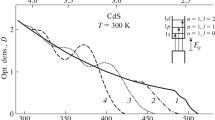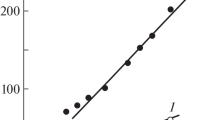The absorption edge of CdSe and CdSSe microcrystals has been observed to undergo a significant short-wavelength shift (of more than 30 meV) during excitation by light pulses at the second harmonic from a Nd:YAG laser. An optical-nonlinearity mechanism is proposed. This mechanism involves the filling of levels in the energy spectrum of a spatially bounded multiexciton system in microcrystals with a size comparable to the exciton radius.
Similar content being viewed by others
Avoid common mistakes on your manuscript.
Considerable interest has recently been shown in the search for and study of dynamic nonlinearities in semiconductor systems of reduced dimensionality [1, 2]. Some unusually strong nonlinear effects were recently observed in quasi-2D GaAs/AlGaAs structures [3]. In the present letter we report the first experimental observation of a nonlinearity in the optical absorption of quasi-0D structures consisting of semiconductor microcrystallites dispersed in a transparent dielectric matrix.
The CdSe and CdSSe microcrystallites were grown in a matrix of an oxide glass through a diffusion-controlled phase decomposition of a supersaturated solution [4]. The size of the microcrystallites was a ≈ 120 Å. Samples of this glass with a thickness of 1–2 mm were excited by light pulses at the second harmonic from a quasi-cw Nd:YAG laser (λ = 532 nm, pulse length of 100 ns, and repetition frequency of 1 kHz). They were synchronously probed with broad-band light from a cell holding an organic dye solution. The cell was pumped with part of the laser beam.
Figure 1 shows transmission spectra of the CdSe and CdSSe microcrystallites measured in the absence of excitation and at the time of excitation by a laser pulse. We see that the laser excitation causes the absorption edge to shift in the short-wavelength direction, both at liquid-nitrogen temperature and at room temperature. This shift could not be a consequence of the heating of the microcrystallites by the laser pulse, since the absorption edge should shift down the energy scale with a temperature rise.
Transmission spectra of CdSe (T = 300 K) and CdSSe (T = 80 K) microcrystallites. The size of the microcrystallites is a \( \simeq \) 120 Å. Solid lines show the results obtained without excitation; dot-dashed lines, with excitation by light at a wavelength λ = 532 nm with a power density P \( \simeq \) 2 MW/cm2.
To study the dynamics of the bleaching near the absorption edge, we probed samples containing CdSe with the cw beam from a krypton laser (λ = 6764 Å) and excited it with pulses at the second harmonic of the Nd:YAG laser (τ = 100 ns). At the time of the application of the exciting pulses we detected an increase in the transmission at the frequency of the krypton laser. The shape of the light pulses from the krypton laser, which were transmitted through the samples, reproduced the shape of the pump pulses. The lifetime of the bleached state thus does not exceed 100 ns.
Figure 2 shows the transmission of the CdSe microcrystallites at the wavelength λ = 6764 Å as a function of the pump density according to measurements taken at T = 80 K. We see that a significant bleaching is achieved at a comparatively low power density of the pump beam, P \( \lesssim \) 1 MW/cm2.
The nonlinearity mechanisms which have been discussed [5] for II–VI single crystals cannot explain the short-wavelength (!) shift of the absorption edge observed in these microcrystallites, which reaches 35 meV. The observed effect might be related to particular features of the energy spectrum of a multiexciton system which arises during intense excitation and which is spatially bounded by the dimensions of the microcrystallite. In microcrystallites with a radius a comparable to the exciton radius rexc (for CdSe, xexc \( \simeq \) 60 Å) the shift of the absorption edge should occur even during excitation of the second electron–hole pair.
Let us consider the formation energy of the second electron–hole pair in a microcrystallite in the case in which the hole mass is much greater than the electron mass: mh \( \gg \) me. As has been shown previously, the interaction with an electron results in the localization of a hole at the center of a microcrystallite over the entire size region a \( \lesssim \) 3rexc [6, 7]. This effect corresponds to a minimum energy of the system. The same energetically preferred configuration of the second electron–hole pair cannot be achieved because of the Coulomb repulsion of the holes. Its excitation thus requires additional energy.
To find a quantitative estimate of this effect, it is convenient to work with microcrystallites with a size a < rexc, since in this case the energy of the size quantization of the electrons, ~\({{\hbar }^{2}}\)/mea2, is much greater than the energy of the Coulomb interaction of electrons with holes and with each other: e2/κa, where κ is the permittivity of the semiconductor. In this case, two electrons in the lower quantum-size level create, by virtue of their Coulomb field, an adiabatic potential which acts on the holes [8]:
where xh = rh/a, and Cin(x) is the integral cosine. This potential has a minimum at the center of this sphere, and one of the holes may localize at it.Footnote 1 In this case the binding energy of the hole is twice that of a single electron–hole pair [6], E1h ≈ –2.4(e2/κa). The energy of the second hole is now determined both by potenti-al (1) and by the Coulomb potential of the first hole, localized at the center of the microcrystallite, e2/κrh. This quantity reaches a minimum at rh = 0.5a; this minimum value is E2h ≈ –1.6e2/κa. On the other hand, the energy of the electrostatic repulsion of two electrons in the first quantum-size level is Ee ≈ 1.8e2/κa. As a result, we find that the minimum additional energy required for the excitation of a second electron–hole pair is Δ = E2h + Ee ≈ 0.2e2/κa.
An even greater energy of the exciting photon is required for producing a third electron–hole pair in microcrystallites with a/rexc. In this case, the Pauli principle states that a third electron cannot occupy that 1s lower quantum-size level, while the next level, a 1p level, is separated by a distance (\({{\hbar }^{2}}\)/2mea2)(ϕ2 – π2), where ϕ ≈ 4.5 [8]. This circumstance should result in an even greater shift of the absorption edge in the short-wavelength direction.
This nonlinearity mechanism, involving the filling of the levels of a spatially bounded multiexciton system, should also be manifested in the luminescence spectra of microcrystallites. Indeed, we see in Fig. 3 that an increase in the pump intensity leads to a broadening of the recombination-radiation band, because of a shift of the short-wavelength edge, while the long-wavelength edge remains essentially unchanged.
In summary, glass samples activated with semiconductor microcrystallites demonstrate a pronounced nonlinearity in optical properties and constitute a promising system for studying nonlinear effects in semiconductor systems with reduced dimensionality.
Notes
Here and below, we are ignoring the motion of the hole, assuming that its mass is infinite (mh → ∞).
REFERENCES
P. Roussignol, D. Ricard, K. C. Rustagi, and C. Flutzanis, Opt. Commun. 55, 142 (1985).
L. Banyai and S. W. Koch, Phys. Rev. Lett. 57, 2722 (1986).
D. S. Chemla and D. A. Miller, Opt. Soc. Am. B 2, 522 (1985).
V. V. Golubkov, A. I. Ekimov, A. A. Onushchenko, and V. A. Tsekhomskii, Fiz. Khim. Stekla 6, 511 (1980).
C. Klingshirn and H. Haug, Phys. Rep. 70, 315 (1981).
A. I. Ekimov, A. A. Onushchenko, and Al. L. Éfros, JETP Lett. 43, 376 (1986).
A. I. Ekimov, A. A. Onushchenko, S. K. Shumilov, and Al. L. Éfros, Sov. Tech. Phys. Lett. 13, 115 (1987).
Al. L. Éfros and A. L. Éfros, Sov. Phys. Semicond. 16, 772 (1982).
ACKNOWLEDGMENTS
We wish to thank L.V. Keldysh and A.L. Éfros for support and discussions of this study.
Funding
This work was supported by ongoing institutional funding. No additional grants to carry out or direct this particular research were obtained.
Author information
Authors and Affiliations
Corresponding author
Ethics declarations
The authors of this work declare that they have no conflicts of interest.
Additional information
Translated by D. Parsons
Publisher’s Note.
Pleiades Publishing remains neutral with regard to jurisdictional claims in published maps and institutional affiliations.
Rights and permissions
Open Access. This article is licensed under a Creative Commons Attribution 4.0 International License, which permits use, sharing, adaptation, distribution and reproduction in any medium or format, as long as you give appropriate credit to the original author(s) and the source, provide a link to the Creative Commons license, and indicate if changes were made. The images or other third party material in this article are included in the article’s Creative Commons license, unless indicated otherwise in a credit line to the material. If material is not included in the article’s Creative Commons license and your intended use is not permitted by statutory regulation or exceeds the permitted use, you will need to obtain permission directly from the copyright holder. To view a copy of this license, visit http://creativecommons.org/licenses/by/4.0/.
About this article
Cite this article
Vandyshev, Y., Dneprovskiĭ, V., Ekimov, A. et al. Nonlinear Optical Properties of Semiconductor Microcrystals. Jetp Lett. 118 (Suppl 1), S6–S8 (2023). https://doi.org/10.1134/S002136402313012X
Received:
Revised:
Accepted:
Published:
Issue Date:
DOI: https://doi.org/10.1134/S002136402313012X







